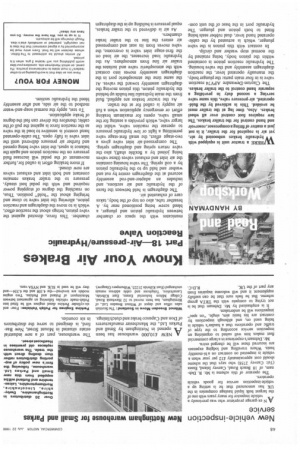Know Your Air Brakes
Page 50

If you've noticed an error in this article please click here to report it so we can fix it.
Part 18—Air-pressure/Hydraulic Reaction Valve
WHERE a tractor unit is equipped with hydraulic brakes unboosted by air, yet air is required for the trailer, it is not just a matter of fitting a compressor, reservoir and hand control for the trailer brakes. The law requires foot control over all wheel brakes. Also, time lag at the trailer must be avoided. This is achieved by the fluidoperated, air-pressure valve, this same valve serving a second duty in providing a separate hand control to the trailer brakes,
The Clayton-Dewandre APV74 reaction valve is in four main parts: the plunger body, the manually operated lever, the reaction diaphragm assembly and the valve housing. The hydraulic reaction piston is contained within the piston body, being retained by the normal stop washer and circlip.
In contact With this piston is the valve plunger, which is actuated by the cableoperated hand lever, dual rubber seals being fitted to both piston and plunger. The hydraulic port in the base of the unit corn
municates with the space or chamber between hydraulic piston and plunger, a bleed screw being positioned near by. A breather tube, also on top of the body, takes care of exhausted air.
The diaphragm is held between the faces of the hydraulic and air sections, and includes an adapter-and-rod assembly secured at the diaphragm centre by nut and washer and held up to the hydraulic piston by a coil spring. The valve housing contains the air inlet and exhaust valves (these valves being joined by a flexible shaft), also the valve return spring and diaphragm spring.
The compressed-air inlet valve gives a two-stage effect, the small first-stage valve permitting a light or low hydraulic pressure to operate the reaction valve, whilst the larger valve, which provides a seating for the small valve, opens for maximum braking effort or emergency application when a full air supply is called for at the trailer.
As the tractor brakes are applied, fluid from the main hydraulic line builds up behind the hydraulic piston, this piston moving the diaphragm assembly toward the valves. At the same time the atmospheric port in the diaphragm assembly moves into contact with the atmospheric valve and isolates the trailer air line from atmosphere. As the hydraulic load increases, the air load on the first-stage inlet valve is overcome, the valve moves from its seat and compressed air enters the line to the trailer brake chambers.
As air is delivered to the trailer brakes, equal pressure is building up in the diaphragm chamber. This force, directed against the valve piston, brings about the reaction effect, which is to move the diaphragm and reaction piston, allowing the inlet valve to close and bringing about the "hold" position. Thus, on reaching the degree of stopping power required and with the pedal heel steady, pressure to the trailer brakes remains constant and both inlet and exhaust valves are now closed.
If more braking effort is called for, further movement of the pedal will increase fluid pressure on the reaction piston and again the balance is upset, the inlet valve being opened and further air pressure delivered until the inlet valve is fully open. The cable-operated hand control is sensitive to load in the valve as the reaction force is against the pull of the cable; therefore the driver can feel the degree of brake application.
To test, apply the normal soap-and-water method to the air side, and after assembly bleed the hydraulic section.
























































































































